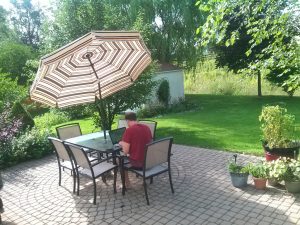Environmentally safe lawn care plans can be easy
Chronicle Media — August 21, 2016
Turf grass in northern Illinois is typically made up of cool season grasses that actively grow when temperatures are lower in spring and autumn. Photo by Chronicle Media
Do you assume a lush, green lawn requires heavy application of fertilizers and pesticides, or hours of backbreaking weed pulling?
Kim Ellson, a University of Illinois Extension horticulture educator, says there is a way to maintain an attractive lawn with environmentally friendly methods that don’t require major effort.
“There are some simple changes you can make that will reduce the environmental impact of your lawn, and help keep your lawn attractive,” Ellson explains. “These include using organic fertilizers and pesticides, grasscycling, mowing methods, alternative grass species, and achieving healthy soils.”
Turf grass in northern Illinois is typically made up of cool season grasses that actively grow when temperatures are lower in spring and autumn. Fertilizer applications should be made during these times.
“The simplest change to reduce chemicals in one’s environment is by replacing synthetic fertilizers with organic fertilizers,” Ellson suggests. “Organic fertilizers are naturally slow-release and add organic matter to the soil with every application.”
Another easy change is “grasscycling,” the practice of leaving lawn clippings on the lawn to break down naturally and serve as a soil amendment.
“For many people, the thought of leaving grass clippings on their lawn is frightful,” Ellson admits. “But if the grass is cut frequently, the clippings will be short enough to fall between the existent grass blades and break down rapidly.”
She says a dried hay appearance on the lawn means the clippings are too long and the grass should be cut more often.
Proper mowing is a critical factor for management without chemicals. Grass should be kept at 2 to 3 inches in height, and should not be cut more than a third of its height when mowing. Lawns cut too short become stressed and vulnerable to drought stress, weed competition, pests, and diseases.
Mower blades should be kept sharp to ensure a clean cut and to avoid shredding the grass. This allows grass to heal efficiently and be less susceptible to diseases.
“No-mow lawns are starting to enter the market and offer an attractive, environmentally friendly alternative, especially suitable for areas in your yard that are not heavily frequented,” Ellson says.
If grass clippings do not decompose quickly, this is a sign that soil microbes and earthworms may be suffering from an overuse of synthetic pesticides. Ellson recommends discontinuing use of these pesticides in such cases.
For gardeners that do have trouble with lawn pests, organic pesticides are available. These introduce fewer environmental risks than their synthetic counterparts. For example, corn gluten is an organic pre-emergent herbicide that is safe for established plants and provides nitrogen fertilizer. Ellson says to apply it prior to weed growth and reapply annually.
“As with all forms of gardening, one has to remain on top of things,” Ellson advises. “Do not allow weeds to get out of control or set seed. A single weed plant can produce incredible amounts of seed.”
A more comprehensive or sustainable approach to lawn care looks at both turf and soil health. Achieving optimal soil health is a long-term project that will require repeated applications of soil amendments and avoiding the use of synthetic chemicals.
“Healthy soils have a high percentage of organic matter and microorganisms, even though we tend to forget about the latter,” Ellson explains. “Adding a thin layer of fine compost to your lawn at least annually is an excellent way to amend your soil. Organic fertilizers and grass clippings also add organic matter, which feeds and sustains the microorganisms that support grass naturally.”
For new lawns, the selection of suitable grass types can ensure a turf that is more resilient to weather, weeds, pests, and diseases.
“Ultimately the endurance and success of natural lawn care will be determined by people’s mindset and their acceptance of lawns with a slight difference in character,” Ellson says. “Is the convenience of chemicals worth the environmental and health implications for our family and pets?”
Source: Kim Ellson, Extension Educator, Horticulture, kellson@illinois.edu
— Environmentally safe lawn care plans can be easy —







